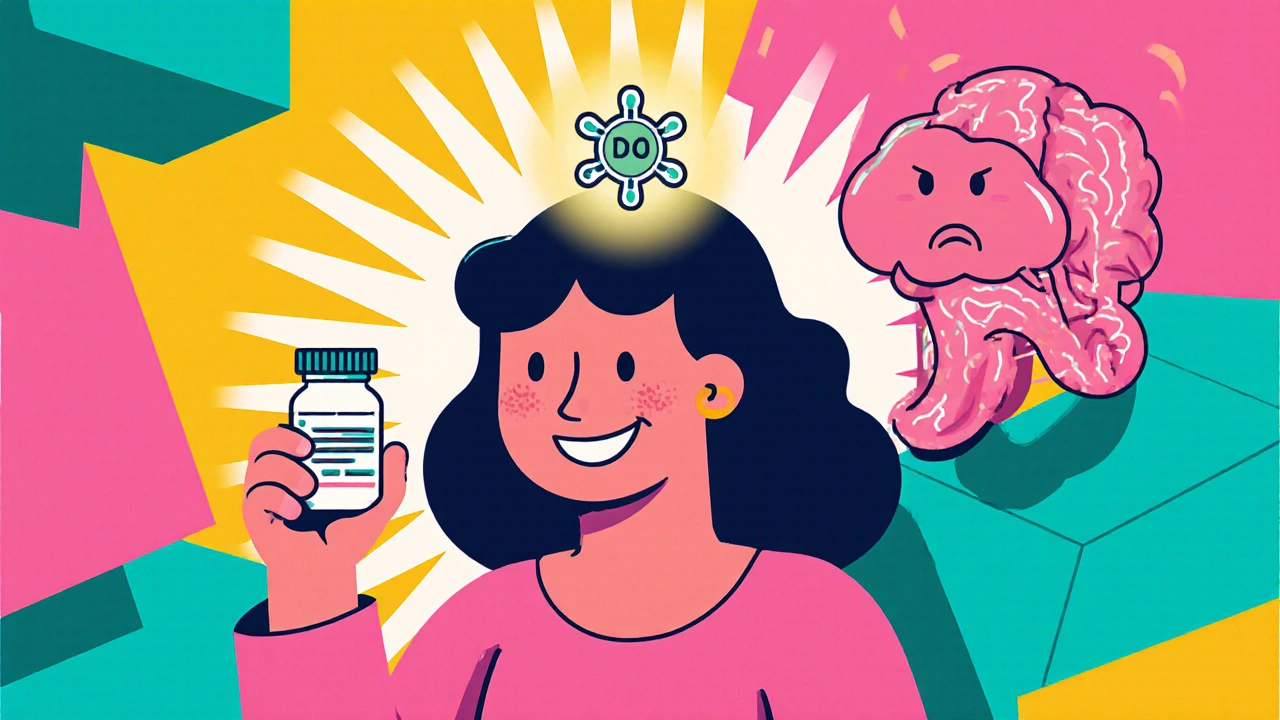Not all tumors need surgery or radiation. For some, a simple pill like cabergoline can shrink them-sometimes even make them disappear. This isn’t science fiction. It’s everyday medicine for people with prolactinomas, a type of benign brain tumor that causes the pituitary gland to make too much prolactin. And cabergoline is one of the most effective tools doctors have to treat it.
What is a prolactinoma?
A prolactinoma is a noncancerous tumor on the pituitary gland, a pea-sized organ at the base of your brain. It doesn’t spread like cancer, but it can cause big problems by overproducing prolactin, the hormone that triggers breast milk production. Too much prolactin can lead to irregular periods, infertility, low libido, and even breast milk in people who aren’t pregnant or nursing. In men, it can cause erectile dysfunction, reduced body hair, and loss of muscle mass.
These tumors are more common than you might think. About 40 out of every 100,000 people have one. Women are diagnosed more often, especially in their 30s and 40s, but men get them too-and often with larger tumors because symptoms are missed longer.
How cabergoline works
Cabergoline is a dopamine agonist. That means it mimics dopamine, a natural brain chemical that tells the pituitary gland to slow down prolactin production. Think of it like flipping a switch: when dopamine binds to receptors on the tumor, it signals the cells to stop making prolactin. As prolactin levels drop, the tumor often shrinks.
Studies show that in over 80% of cases, cabergoline reduces prolactin levels back to normal within weeks. In about 70% of patients, the tumor shrinks by at least half. For many, it disappears on MRI scans entirely. That’s rare for any tumor treatment-especially one you take as a pill twice a week.
Who benefits most from cabergoline?
Cabergoline works best for small to medium-sized prolactinomas. The smaller the tumor, the better the response. People with tumors under 1 centimeter (microprolactinomas) often see full remission. Even larger ones (macroprolactinomas), up to 2 or 3 centimeters, usually shrink enough to relieve pressure on nerves and restore hormone balance.
It’s also the first choice for women who want to get pregnant. Unlike surgery, cabergoline doesn’t leave scars or risk damaging the pituitary. Once prolactin drops, ovulation returns. Many women conceive within months of starting treatment.
Men with prolactinomas respond just as well. Low testosterone and sexual dysfunction often improve within weeks. Muscle mass and energy levels bounce back. For many, it’s life-changing.

Side effects and risks
Cabergoline isn’t perfect. Some people feel dizzy, nauseous, or get headaches when they start. These usually fade after a few days. Taking it with food helps. A small number report nasal congestion or constipation.
More serious side effects are rare. Heart valve issues were linked to high-dose cabergoline used for Parkinson’s disease-but the doses for prolactinomas are much lower. Long-term studies tracking patients for over 10 years show no increased risk of heart problems at standard doses.
One warning: if you have a history of heart valve disease or fibrosis in the lungs or abdomen, your doctor might choose another medication. But for most people, the benefits far outweigh the risks.
How it compares to other treatments
Before cabergoline, surgery was the main option. But even the best pituitary surgeons can’t remove every tumor cell, and recurrence rates are around 20-30%. Plus, surgery carries risks like bleeding, infection, or damage to nearby nerves.
Another drug, bromocriptine, was used for decades. It works similarly but has more side effects-especially nausea and dizziness-and needs to be taken multiple times a day. Cabergoline lasts longer in the body, so you only take it once or twice a week. It’s also more effective at shrinking tumors.
Here’s how they stack up:
| Treatment | Dosing Frequency | Shrinkage Rate | Common Side Effects | Success Rate |
|---|---|---|---|---|
| Cabergoline | 1-2 times per week | 70-80% | Nausea, dizziness, headache | 85-90% |
| Bromocriptine | 2-3 times per day | 50-60% | Severe nausea, low blood pressure | 65-70% |
| Surgery | One-time procedure | 60-70% | Bleeding, infection, hormone loss | 70-80% (recurrence: 20-30%) |
Cabergoline is now the global standard for first-line treatment. Guidelines from the Endocrine Society, the European Society of Endocrinology, and the American Association of Clinical Endocrinologists all list it as the preferred option.
How long do you take it?
Most people take cabergoline for years. Some stay on it for life. But here’s the good news: if your prolactin levels stay normal for two or more years and your tumor is gone on MRI, your doctor might try lowering the dose-or stopping it entirely.
Studies show that about 40% of patients can stop treatment without the tumor coming back. The chance of relapse is higher if the tumor was large to begin with, or if prolactin levels were extremely high before treatment.
Regular blood tests and MRIs help monitor progress. If prolactin starts rising again, restarting cabergoline usually brings things back under control.

Other tumors cabergoline might help
While prolactinomas are the main use, research is looking at cabergoline for other tumors. Some rare pituitary tumors-like somatotropinomas (which cause acromegaly) or non-functioning adenomas-also have dopamine receptors. Early trials show modest shrinkage in some cases.
There’s also early-stage research into whether cabergoline can slow growth in certain breast or pancreatic tumors. But these are still experimental. For now, the only proven use is for prolactin-secreting tumors.
What to expect when you start
If your doctor prescribes cabergoline, you’ll likely start with a low dose-0.25 mg once or twice a week. After a few weeks, they’ll check your prolactin level and adjust the dose. Most people reach the right dose within 2-3 months.
You’ll notice changes fast. Headaches from tumor pressure often ease within days. Women may get their period back within a month. Men report improved energy and libido within weeks.
Don’t stop taking it just because you feel better. Even if symptoms vanish, the tumor might still be there. Stopping too soon can cause it to grow back.
When surgery or radiation might still be needed
Cabergoline works for most-but not all. About 10-15% of patients don’t respond well. If your tumor keeps growing despite high doses, or if you can’t tolerate the side effects, surgery becomes the next step.
Radiation therapy is rare. It’s usually saved for tumors that come back after surgery and don’t respond to drugs. It takes years to work and can damage nearby healthy tissue, so it’s a last resort.
But for the vast majority, cabergoline is enough. It’s safe, effective, and easy to take. Many patients say it gave them their life back.
Can cabergoline cure a prolactinoma?
Cabergoline doesn’t always permanently cure prolactinoma, but it can put it into long-term remission. In many cases, the tumor shrinks so much it’s no longer visible on scans. About 40% of people who take it for two or more years can stop treatment without the tumor returning. But for others, especially those with larger tumors, lifelong treatment may be needed to keep prolactin levels normal.
How quickly does cabergoline work?
Prolactin levels often drop within days. Symptoms like headaches, vision problems, or irregular periods usually improve within weeks. Tumor shrinkage takes longer-typically noticeable on MRI scans after 3 to 6 months. Full shrinkage can take a year or more, depending on the size of the tumor.
Is cabergoline safe for long-term use?
Yes. Studies tracking patients for over 15 years show cabergoline is safe at standard doses used for prolactinomas. Unlike higher doses used in Parkinson’s, the low doses for pituitary tumors haven’t been linked to heart valve damage. Regular check-ups and blood tests help ensure safety over time.
Can I take cabergoline while pregnant?
Yes. Cabergoline is often stopped once pregnancy is confirmed, because the body naturally increases prolactin during pregnancy. But many women continue taking it in early pregnancy if the tumor is large, to prevent growth. Studies show no increased risk of birth defects. Always talk to your doctor before making changes.
What happens if I miss a dose?
If you miss one dose, take it as soon as you remember. If it’s almost time for your next dose, skip the missed one. Don’t double up. Missing doses occasionally won’t cause immediate problems, but regular missed doses can let prolactin rise again and the tumor grow back.
Cabergoline changed how we treat prolactinomas. It turned a condition that once required risky brain surgery into something manageable with a weekly pill. For thousands of people, it means getting back to normal life-without scars, without hospital stays, and without losing years to symptoms nobody understood.



November 1, 2025 AT 06:42 AM
Cabergoline is wild-like a magic pill that makes brain tumors vanish. I’ve seen it in action with a friend. No surgery, no scars, just a weekly pill and boom-normal life again.
November 1, 2025 AT 09:13 AM
why do people make this sound like a miracle drug its just dopamine agonist 101. also side effects arent just nausea they can make you hallucinate if you dose wrong
November 1, 2025 AT 14:25 PM
For anyone scared to start this-start low, go slow. My doc gave me 0.25mg once a week. Felt fine. No nausea. By week 4 my energy was back. Took 6 months for the tumor to shrink on scan-but I didn’t quit. It worked.
November 3, 2025 AT 09:52 AM
OMG I’M SO GLAD THIS EXISTS!! I was told I’d never have kids because of my prolactinoma… now I’m 7 months pregnant and my tumor is GONE. Cabergoline didn’t just save me-it gave me a baby. 🙏💖
November 4, 2025 AT 01:39 AM
usa always hype their drugs. in india we use bromocriptine its cheaper and works fine. why pay 10x more for same effect
November 4, 2025 AT 09:28 AM
While the efficacy of cabergoline in the context of prolactinoma management is statistically compelling, one must interrogate the longitudinal pharmacoeconomic implications of its widespread adoption. The pharmaceutical industry’s influence on endocrine guidelines is not inconsequential, and the apparent superiority of cabergoline over bromocriptine may be partially attributable to aggressive marketing campaigns rather than unequivocal clinical superiority. Moreover, the long-term cardiac safety profile, though currently deemed acceptable, remains inadequately studied in populations with pre-existing valvular pathology.
Furthermore, the assertion that 40% of patients can discontinue therapy without relapse is misleading without stratification by tumor size, baseline prolactin levels, and duration of treatment. The data cited lacks granularity, and the reliance on MRI-defined remission introduces selection bias, as patients with residual tumor tissue may be excluded from follow-up cohorts.
The comparison table, while visually appealing, omits critical variables such as patient adherence rates, cost-per-response, and quality-of-life metrics. One might argue that the convenience of dosing frequency does not compensate for the psychological burden of lifelong pharmacological dependency in younger patients.
Additionally, the dismissal of surgical intervention as inherently risky is a gross oversimplification. Endoscopic endonasal approaches, performed by experienced neurosurgeons, now boast recurrence rates below 10% and complication profiles comparable to those of medical therapy. The privileging of pharmacotherapy as first-line may inadvertently delay definitive intervention in patients with macroadenomas and visual field defects.
Finally, the romanticization of cabergoline as a ‘life-changing pill’ risks minimizing the lived experience of patients who suffer from refractory disease, intolerable side effects, or psychological sequelae of chronic illness. Medicine is not a fairy tale-it is a complex, imperfect science.
November 5, 2025 AT 08:19 AM
why is everyone acting like this is some american miracle. i got my dad on this stuff in 2018 and he’s been fine. but in the usa you got to pay 300 a month for it. in other countries its like 10 bucks. this whole thing is just pharma greed wrapped in a white coat
November 5, 2025 AT 21:47 PM
Wait… so… you’re telling me… that a pill… can shrink a tumor… in the brain… without surgery…? And… it’s… FDA-approved…? I’m just… confused. I thought tumors were… like… evil monsters that needed lasers. Or knives. Or both. Why is this so… simple?
November 7, 2025 AT 03:27 AM
I’m from the Midwest and my cousin took this after her diagnosis. She went from barely leaving the house to hiking mountains in a year. No one talks about how this drug gives people back their dignity. Not just their health-just… their life.
November 8, 2025 AT 15:17 PM
Life-changing stuff. 🙌 I used to cry every time I looked in the mirror because I was leaking milk and no one believed me. Now? I’m coaching cross-country. Cabergoline didn’t fix my tumor-it fixed my soul.
November 10, 2025 AT 12:17 PM
If you’re reading this and scared to start this med-just talk to your doctor. Don’t wait. I waited two years. My tumor grew. I wish I’d known sooner. You deserve to feel like yourself again.
November 10, 2025 AT 12:54 PM
As a graduate of Johns Hopkins Medical School, I must say the author’s casual tone undermines the gravity of neuroendocrinology. Cabergoline’s mechanism is not ‘flipping a switch’-it is a complex modulation of D2 receptor signaling cascades involving G-protein coupling and intracellular cAMP suppression. The reductionist language here is not merely unprofessional-it is intellectually dishonest.
November 10, 2025 AT 18:32 PM
So… you’re saying this drug works better than surgery? I’m not saying surgery is better but… why are we so quick to avoid it? Maybe we’re just scared of the knife. Or maybe the doctors just want to keep prescribing.
November 11, 2025 AT 05:43 AM
In South Africa we have no access to cabergoline. We use bromocriptine. It’s cheaper. It’s available. But it makes you vomit all day. So yes, cabergoline is great. For people who can afford it. For the rest of us? We pray.
November 13, 2025 AT 03:04 AM
I’m a nurse in Vancouver and I’ve seen this work wonders. One guy came in with a 2.5cm tumor, couldn’t see out of his left eye. Six months on cabergoline? Vision back. Tumor gone. He started coaching his kid’s soccer team. That’s the real win.
November 13, 2025 AT 12:10 PM
Why are we giving pills to brain tumors? Shouldnt we cut it out? This feels like cheating. Like taking a shortcut. And shortcuts are dangerous.
November 13, 2025 AT 15:29 PM
While the article is meticulously structured and clinically accurate, I find it profoundly disturbing that such a transformative medical intervention is being presented as ‘everyday medicine.’ This normalization of pharmaceutical dominance over surgical intervention reflects a broader cultural erosion of medical rigor. We are becoming a society that prefers convenience over courage.
November 14, 2025 AT 08:58 AM
lol this is why americans think they invented medicine. we’ve been using this in india since the 90s. its just dopamine. not rocket science. also its not even first line anymore in europe. they use quinagolide now. but sure keep your expensive pills
November 15, 2025 AT 03:46 AM
Let’s be real-this drug is a miracle. But let’s also be real: the reason it’s not in every country is because it’s too profitable for Big Pharma to let it be cheap. We’re not celebrating science-we’re celebrating capitalism with a stethoscope.